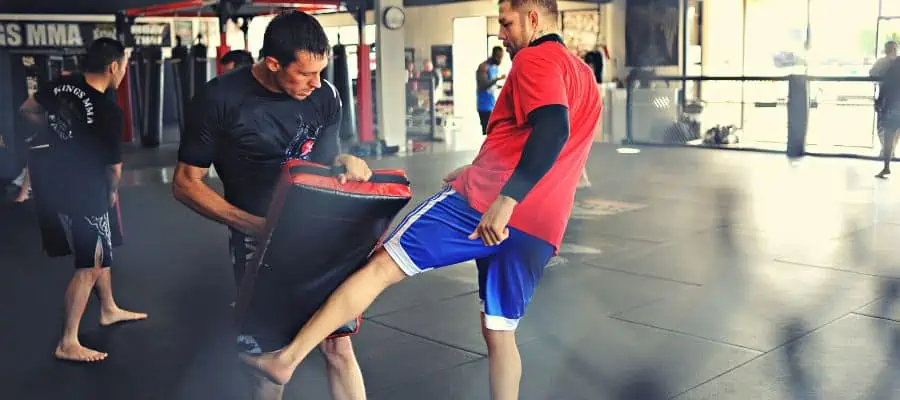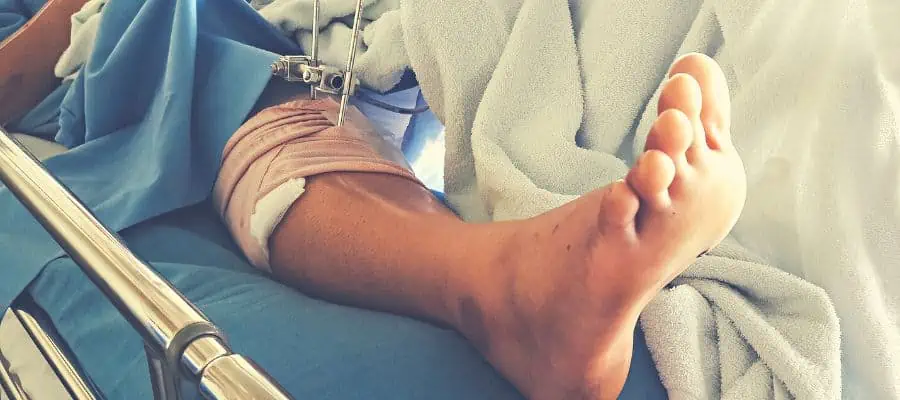A broken leg is one of the most common injuries in MMA. And this injury can be quite gruesome and hard to watch. This injury has happened to several fighters, including Anderson Silva, Corey Hill, and Chris Weidman.
But why do MMA fighters break their legs, and can it be prevented? In General, MMA fighters may break their legs due to the high-impact nature of the sport, where powerful strikes and kicks are exchanged between opponents. When fighters attempt leg kicks, the force generated can be immense. If the opponent effectively checks the kick by raising their knee or shin, the impact can cause the attacker’s leg bones to break.
However, there are some precautions you can take to lower the chances of this happening to you.
Why Do Fighters Break Their Legs?

Leg kicks are a staple technique in MMA, used to damage the opponent’s legs and slow them down. However, leg kicks can also cause injuries, including broken legs. When a fighter throws a leg kick, they often aim for the lower leg, just above the ankle.
The tibia, which is the larger of the two bones in the lower leg, is most commonly fractured during leg kicks. The force of the kick can cause the bone to fracture, resulting in a painful injury. This type of injury is common in fighters who use a lot of leg kicks, such as Muay Thai fighters.
Similarly, if a fighter misses with their shin and hits the opponent with their foot, especially in the knee, they can injure themselves. The upper foot has smaller, more fragile bones, which can break much easier than shin bones.
This type of injury is often caused by the foot striking the hard bone of the knee, causing a fracture in the bones of the foot. These types of injuries can take a long time to heal and can have lasting effects on a fighter’s ability to compete.
Improper Technique
Improper technique is another common cause of broken legs in MMA. When fighters are tired or not using proper form, they can put themselves at risk of injury. For example, suppose a fighter throws a kick with their foot positioned incorrectly. In that case, they can put too much stress on their leg, causing a fracture.
Similarly, if a fighter lands awkwardly after a strike or a jump, they can injure their leg. A common example is when a fighter lands with their leg extended after attempting a high kick. This can cause the knee joint to hyperextend, resulting in a ligament “snapping.”
Pre-Existing Injuries
Pre-existing injuries can also lead to broken legs in MMA. If a fighter has an old injury, such as a stress fracture or a torn ligament, their leg may not be able to handle the stress of a fight. Even a minor injury can become a major problem during a fight, leading to a fracture.
This is why many MMA fighters prioritize rest and recovery to ensure their bodies are in top shape before entering the octagon. Fighters need to seek proper medical attention for any pre-existing injuries and allow sufficient time for healing before returning to training and fighting.
Repeated Stress
In addition to the causes mentioned above, another factor contributing to broken legs is the repeated stress that the legs endure during training and fights. Over time, this stress can weaken the bones, making them more susceptible to fractures. This is why many fighters incorporate strength and conditioning exercises into their training regimen to strengthen their legs and reduce the risk of injury.
What Are The Types Of Leg Injuries In MMA?

Tibia And Fibula Fractures
The most common type of leg injury in MMA is a tibia or fibula fracture. These two bones make up the lower leg and are often subjected to a lot of stress during fights. When a fighter throws a leg kick or lands awkwardly, they can put too much pressure on these bones, causing a fracture. Tibia and fibula fractures can be painful and take several months to heal. In severe cases, surgery may be required to repair the damage.
Knee Ligament Tears
Knee ligament tears are another common type of leg injury in MMA. The knee is a complex joint that is subjected to a lot of stress during fights. When fighter twists or lands awkwardly, they can tear one of the ligaments in their knee.
The anterior cruciate ligament (ACL) is MMA’s most commonly injured knee ligament. This type of injury can be very painful and can require surgery to repair. Recovery from a knee ligament tear can take several months, and fighters may need to undergo rehabilitation to regain their strength and mobility.
Dislocations
Dislocations occur when a joint is forced out of its normal position. In MMA, dislocations can occur in the hip, knee, or ankle. When a fighter is taken down or thrown, they can land awkwardly, causing a dislocation.
This type of injury can be very painful and can require immediate medical attention. Treatment for a dislocation involves resetting the joint. The fighter may need to wear a brace or cast to immobilize the joint while it heals.
Contusions, Abrasions, Sprains
In addition to these common leg injuries, fighters may experience strains, sprains, contusions, and abrasions. These types of injuries are typically less severe than fractures, tears, or dislocations. However, they can still be very painful and may require time off from training and fighting to allow for proper healing.
Contusions and abrasions are minor leg injuries that can occur during fights. Contusions are bruises resulting from a direct blow to the leg, while abrasions are scrapes or cuts on the skin. Although these injuries are minor, they can still impact a fighter’s performance and require proper care to prevent infection.
What Are The Long-Term Impacts Of Leg Injuries On Fighters?

Leg injuries can have significant physical impacts on MMA fighters. They can prevent them from training and competing, leading to lost opportunities and income. Moreover, these injuries can cause chronic pain and limit mobility, affecting the fighter’s quality of life even after they retire from the sport. In some cases, the physical impact of a leg injury can be so severe that the fighter is forced to retire early.
Leg injuries can also have significant psychological impacts on fighters. In addition to physical pain, the injury can lead to feelings of frustration, anxiety, and depression. A leg injury can be especially devastating for fighters who have built their careers on their physical abilities. They may feel like they have lost their identity and are uncertain whether they can return to the sport they love.
MMA fighters rely on their ability to compete and win to earn a living. A leg injury can significantly impact a fighter’s income, especially if they cannot compete for an extended period. In addition to lost income, they may also face significant medical bills and rehabilitation costs, which can add to their financial stress.
How To Prevent Leg Injuries?

Proper Training And Technique
Proper training and technique are essential for preventing leg injuries in MMA. Fighters should learn the correct form for each technique and practice them consistently to avoid the risk of injury. They should also be mindful of their limitations and avoid pushing themselves too hard. Another crucial aspect of training is the gradual development of microfractures in the shin bone.
In MMA, fighters often use their shins to deliver kicks, which can lead to bone microfractures. These micro-fractures are tiny cracks in the bone that, over time, heal and strengthen the bone in that spot. To develop these microfractures, fighters can gradually hit a heavy bag or a light, hard object with their shins over time. This process helps to condition and strengthen the bone, making it less likely to break during a fight.
Strengthening Exercises
Strengthening exercises are also essential for preventing leg injuries in MMA. Fighters should focus on developing strong lower leg muscles, such as the calves and shins, as these muscles are critical for supporting the bones during fights.
Exercises such as calf raises, toe raises, and box jumps can help to build strength in these muscles. Jump rope and road work are also excellent exercises that can help to improve footwork, agility, and endurance while strengthening the legs.
Protective Gear
Protective gear can provide additional leg protection during training and sparring sessions. In particular, Shin guards can help reduce the risk of injury during sparring sessions. They are designed to absorb the impact of kicks, protecting the shins and the bones in the lower legs.
While shin guards are not typically used during fights, they can help to prevent injuries during training, allowing fighters to continue to train and develop their skills without risking injury.
Rest And Recovery
Finally, rest and recovery are crucial for preventing leg injuries in MMA. Fighters should give their bodies time to recover between training sessions and fights. Overtraining can lead to fatigue and an increased risk of injury. A nutritious diet is also essential for promoting recovery and healing.
A diet rich in vitamins and minerals, especially calcium and vitamin D, can help to promote bone health and healing. Moreover, fighters can reduce the risk of microfractures by consuming collagen-rich foods like bone broth, fish, and chicken. These foods can help to promote healthy bone growth and reduce the risk of injury.
What Are The Worst Leg Injuries In MMA?

Anderson Silva vs. Chris Weidman II (UFC 168)
Anderson Silva suffered a gruesome leg injury when he broke his left tibia and fibula while attempting a leg kick against Weidman. Silva’s shin connected with Weidman’s knee, and the impact resulted in the catastrophic break. Silva underwent surgery and eventually made a return to the sport.
Chris Weidman vs. Uriah Hall (UFC 261)
In a twist of fate, Chris Weidman experienced a similar injury to Silva’s when he broke his right tibia and fibula within the first few seconds of the fight against Uriah Hall. Weidman attempted a leg kick, which was checked by Hall, resulting in a devastating injury. Weidman has since undergone multiple surgeries and is on the road to recovery.
Corey Hill vs. Dale Hartt (UFC Fight Night 16)
Corey Hill suffered a horrific leg break in his bout against Dale Hartt. Hill threw a leg kick that was checked by Hartt, which caused Hill’s right tibia and fibula to snap. Hill underwent surgery and eventually returned to fighting, but his career never fully recovered from the injury.
Sofiane Boukichou vs. Tom Aspinall (Cage Warriors 101)
Sofiane Boukichou experienced a gruesome leg break in his fight against Tom Aspinall. Boukichou threw a leg kick that was checked by Aspinall, which resulted in a horrific break of his right leg. Boukichou received medical attention and has since fought multiple fights.
Also be sure to check another MMA fighters who broke their legs.
Conclusion
In conclusion, leg injuries are common in MMA, with broken legs being one of the most severe types of injuries. Leg kicks, improper technique, pre-existing injuries, and other factors can all contribute to these injuries. Fighters should focus on proper training and technique, strengthening exercises, protective gear, and rest and recovery to prevent leg injuries. By taking these steps, MMA fighters can reduce their risk of injury and continue to compete at their best.
Recent Posts
What is Manachai's Fighting Style? Unveiling Muay Thai Mastery
Manachai, a celebrated figure in the Muay Thai world, has captivated audiences with his exemplary martial prowess. Hailing from the heartlands of Thailand, his name is synonymous with the art of...
What Was Chamuekpet Hapalang's Fighting Style? Unveiling Techniques
Chamuekpet Hapalang was a renowned figure in the world of Muay Thai (record 200-48-2), embodying a fusion of Muay Bouk and Muay Khao styles. Originating from Thailand, the art of Muay Thai is known...
